Episode #347: How To Group Students In Math Class: Similar Abilities or Mixed Abilities in Math Classrooms?
LISTEN NOW HERE…
WATCH NOW…
Should students be grouped by similar abilities in math class, or is it better to mix them up? In this episode, we explore the research and practical implications of ability-based and heterogeneous grouping in math classrooms. When does grouping in math class by ability help students thrive, and when does it reinforce inequities? What benefits come from diverse groupings, and how can teachers ensure all students are engaged and challenged? We’ll unpack best practices, common pitfalls, and strategies for making informed decisions about student collaboration and grouping in math class.
What Listeners Will Get From This Episode:
- Practical strategies for grouping students in math class—when to use ability-based groups for targeted support and when to use heterogeneous groups for richer discussions.
- Guidance on choosing the right math tasks—how to match math tasks with the most effective grouping strategy.
- Ideas for keeping groups dynamic—ways to ensure students aren’t stuck in fixed ability groups and have opportunities to grow.
- Techniques to foster equitable participation in math class—how to structure groups so all students contribute and benefit, regardless of skill level.
- Ways to prevent unintentional tracking—tips for avoiding the pitfalls of long-term ability grouping.
- Insights on teacher mindset—how beliefs about student potential shape grouping decisions and learning outcomes.
- Tools for ongoing reflection—how to assess and adjust groupings to maximize engagement and challenge for every student.
Attention District Math Leaders:
Not sure what matters most when designing math improvement plans? Take this assessment and get a free customized report: https://makemathmoments.com/grow/
Ready to design your math improvement plan with guidance, support and using structure? Learn how to follow our 4 stage process. https://growyourmathprogram.com
Looking to supplement your curriculum with problem based lessons and units? Make Math Moments Problem Based Lessons & Units
Be Our Next Podcast Guest!
Join as an Interview Guest or on a Mentoring Moment Call
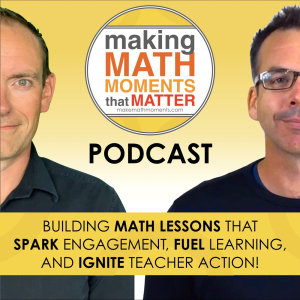
Apply to be a Featured Interview Guest
Book a Mentoring Moment Coaching Call
Are You an Official Math Moment Maker?
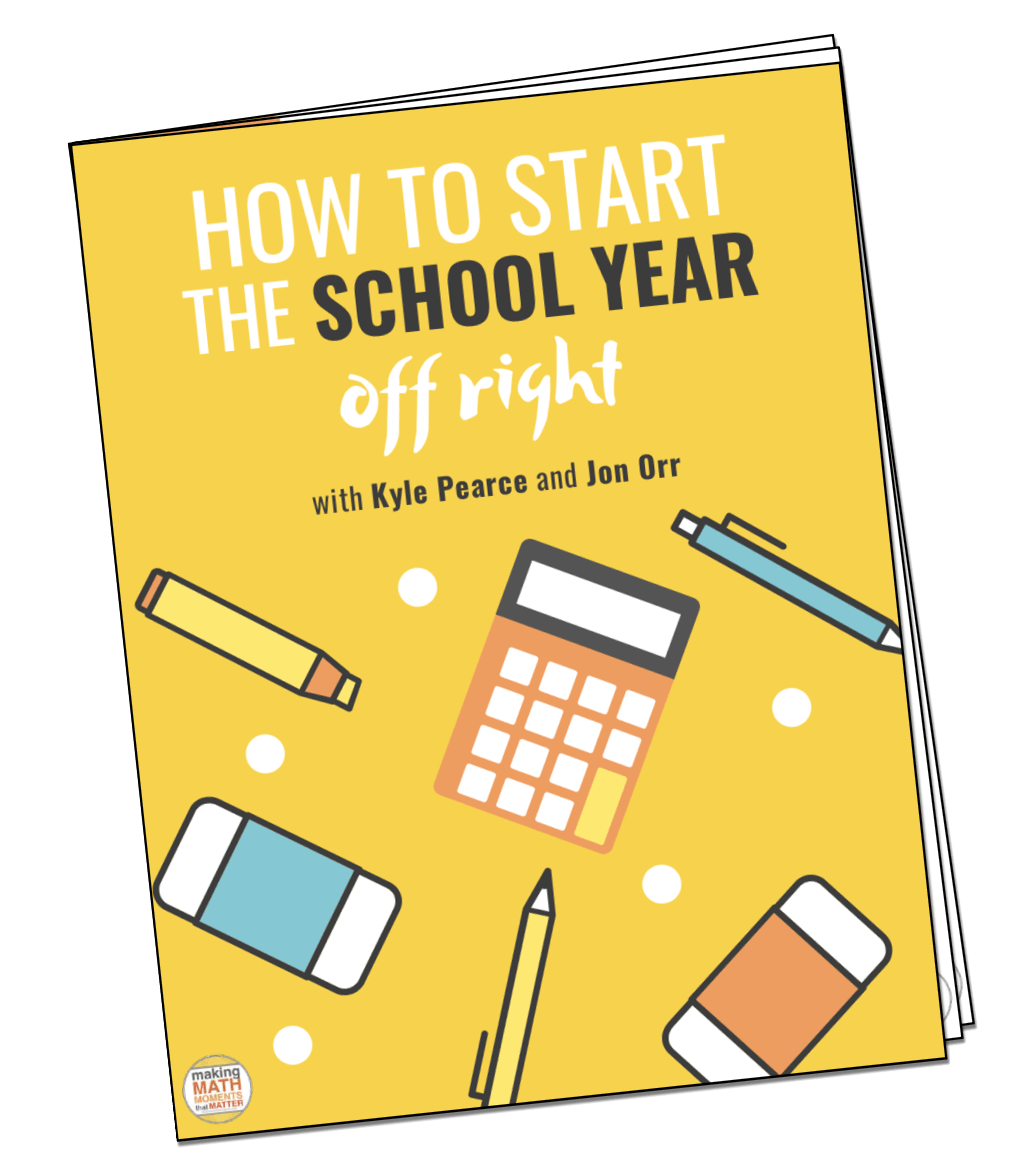
FULL TRANSCRIPT
Yvette Lehman: All right, today we’re going to have a bit of a debate on a topic that has been on my mind lately. I’m always thinking about the context of, you know, the contemporary classroom experience and the demands on math teachers. And one thing that I’ve been wondering lately is sometimes I hear statements that maybe suggest that it’s almost like this all or nothing type response to some of the research that’s out there.
So, you we hear something like flexible grouping or, you know, random groupings. And sometimes we lean into that idea and almost take it to where it’s like, that’s the only type of grouping that’s gonna exist within my classroom. And so I wanna talk through, you know, when that grouping makes sense, but also kind of push back and challenge the idea of that. there’s some situations.
where we do have to group students based on their ability or a particular skill we’re targeting. So that’s going to be kind of our debate today, you know, no judgment. That’s just kind of a authentic conversation.
Jon Orr: I’m gonna judge. I’m gonna judge, I’m gonna judge.
Kyle Pearce: No judgment zone. Yeah. Yeah. Well, you know what, Yvette? I’m so happy, like, this topic came to you, and you presented this topic as something we should dig into. And I think it’s really important that we do dig into it, because, you know, John and I have chatted at length in earlier episodes of the podcast about some of our own
know, missteps along the way. And I think, you know, I want to start and frame it here that as we’re on this journey, it’s really hard to find the balance. And it’s really hard for us to recognize when we’re, we’ll call it like FOMOing into something, right? Like the idea is like, I want to be all in because this thing, it’s like, you can see maybe anecdotally that things are working well and
I vividly remember this at multiple stages in my journey where it was like I was all in on three act math tasks. It was like every single day, three act math task. And you know, I was all in on random grouping and, and vertical non-permanent surface. was like every single day we’re going to do random vertical non-permanent. So, you know, it was like everything and it was, it was trying to evolve. Now here’s the interesting part is like, when we do this process, we typically go all in on something.
then we recognize that it’s like not perfect. So then we look for the next thing. But the problem is, is sometimes we sort of forget and then we do it again. And I’m really curious here to sort of get your thinking as to like what, what brought this on, you know, what brought this idea up for you to bring it forward for us to really dig in here because we really want to make sure that we don’t sometimes when we say something,
How it’s interpreted is like thou must or thou shalt always do X, Y, or Z, and thou shalt never do these other things. So tell us a little bit more about what you’re seeing and what’s inspiring us to kind of dig into this today. And we’ll take it from there. Because I think there’s one that’s really on your mind here today.
Yvette Lehman: Okay, so I’m gonna give a little bit of background for any of our elementary educators listening. We know that here in North America, we’ve been on this science of reading journey over the past few years and really transforming literacy instruction. And I’m just gonna describe something to you that’s true in literacy. And I wonder if we can make connections to the math classroom. So in the literacy classroom, the research suggests that when you’re engaging in…
you know, high level comprehension type tasks. So you’re building vocabulary, you’re building background knowledge, you’re learning about language structures. The recommendation is that when you’re engaging in those cognitively demanding tasks, the group should be heterogeneous. It should be mixed abilities. You know, everybody can contribute or bring their own experience to that environment. But when you are targeting foundational skills in reading, that should be differentiated.
I’m going to find where every child is along their learning trajectory, and I’m going to target the skills that they need at that time to move them forward. And some students may have already closed that scope and sequence, and they don’t need that targeted instruction anymore. They’re beyond it. They’re already fluent. But I might have another student who’s really early in that journey. And so the recommendation in the literacy classroom is that we’re flexible. So there’s times where we’re all together. Everybody should be engaged in that learning.
everybody should be having access to that learning because it’s that critical thinking, cognitively demanding, rich task. But when it comes down to foundational skill development, we need to be differentiated and we need to target specific groups with specific skills. So maybe that’s where this thinking started for me, where it’s like, I see a lot of parallels in the math classroom, where it’s like when we’re engaging in a rich task, a cognitively demanding task,
That’s a time where it’s like we should have visibly random groups, we should allow access for all, we should be valuing thinking from everybody, everybody can bring their own background and experience to that task. But is there also a time in the math classroom where we need to be targeting remediation and foundational skills for students? Where it needs to be differentiated, it needs to be specific, it needs to be based on their developmental entry point along a you know, let’s say a number sense trajectory.
Jon Orr: And I think what you’re trying to bring up here is that when we think about grouping in math class specifically, you’re thinking like, if I believe in random grouping and I believe in heterogeneous grouping is essential for learning math, am I allowed to go down and have, say, specialized grouping and grouping for students
of skill level. And I think it’s like we, we, and this goes to your point at the beginning, is like, we think in absolutes. It’s like, either I’m this type of teacher or I’m this type of teacher. And I don’t, if I believe that random grouping is great for learning, then I can’t believe that say, homogeneous grouping at any time is good for learning. And I think this is, and we, we’ve talked about this, like Kyle said on the podcast about balance.
And we, in event you and I talked about this not too long ago about this, this idea of, of, of strongly held beliefs, but loosely held and saying like, strongly believe in random grouping, but I’m going to loosely hold them because sometimes it makes sense to go over here and do this. And I think, I think where, this was true for me. And I think what Kyle, you were saying is, is kind of saying that he changed as you grow, as long as you have those loosely, those strongly held beliefs, loosely held.
you have the flexibility to change your thinking, you change your practice. And this is how we get better as educators, is you constantly morph and adapt and learn what works and what doesn’t. But I think what happens in math education from our experience, and this happens a lot, especially as we’re trying to shift into ambitious teaching of mathematics, is that we get this identity.
You know, we strongly hold these identities in our math class of saying, I’m this type of teacher, I’m not this type of teacher, and therefore you can’t do anything that that other type of teacher may do, even though it may benefit students at one point. So when I reflect back on say my experience, I remember being like having that identity saying like what you say Kyle, like I’m gonna teach this way, I’m gonna have a building thinking classroom where I’m gonna randomize groups every single day and we’re gonna get up and we’re gonna do some.
form of thinking task and we’re gonna have our five practices for orchestrating productive mathematical discussions type lesson. But when it came down to it, I would say, if someone asked me what I’m doing in my class, I would say that. But then if I reflect honestly, there are days and points along that, even in that lesson where,
you might be pulling two kids, three kids to the side specifically to address say this two step equation that you knew that they needed more assistance on, which is exactly like a homogeneous grouping of ability when those kids over there are say continuing this portion of the lesson. Like we, I was say doing that, but still held this like identity that I wasn’t doing that. And I think we just have to kind of like accept that there are moves.
to be made in our classrooms that are the best for students, we just have to be able to be flexible and make the right move for the kids and not just like say, it’s always this way or it’s always this way. And this is the last point I wanna make here is like, it’s the same thing as a teacher who’s gonna be like, I’m gonna teach by the script every day and I don’t waiver from the script. The same is true if I’m like, I’m teaching ambitiously, but I don’t waiver from this pathway that I feel like I’m on.
Kyle Pearce: Yeah, like I think too, like if we think about the belief idea and you know the loosely held idea, it’s almost like more or less it’s like shifting our beliefs to understand and believe that there are times and places where certain things make a ton of sense. And there’s other times where maybe they don’t. And I think if we think more along those lines, what you’ll recognize as you go, I guess that makes sense. You know, like if we truly believe that like
Every student in our classroom has various skills and abilities. they have different assets that they’re bringing with them. They have different things that maybe aren’t quite there yet, that aren’t developed yet, or that they struggle with. And at the end of the day, for us to think that one approach will work always for all students at all times with every single topic that we need to do, that is
really short-sighted, you know, I think. again, I’m putting me out here because I’m telling you that this was something that I didn’t recognize along the way. And really, if we’re able to find the balance between what will be helpful, because there is the side of it where, you know, and we’re gonna take random grouping, for example. There are so many benefits for doing some random grouping. Keyword is some.
But there’s also so many negatives that could happen if we sort of leave it to chance. And what I mean by this is like when I randomly put students together, there’s a ton of great things that happen. There’s a ton of engagement. There’s a ton of learning that’s taking place. But what about the handful of students that aren’t quite clear on something? Are we just going to leave it to chance? It’s all going to kind of work out. It’s all going to come out in the wash. And I think this is where we then have to go, OK.
And I think this is where, you know, Yvette’s gonna kind of take this idea with the idea of targeting where there are gonna be some students who are like exactly where we want them to be, but there’s probably a lot of other students that aren’t quite there yet. And that we don’t wanna just do more random grouping to hope it irons itself out on its own, because the reality is in most cases, it’s probably not gonna iron itself out if we’re being very intentional.
Yvette Lehman: I had a conversation recently. I was coaching a teacher who is currently in the classroom. And, know, just to describe the context a little bit, this is a combined junior classroom. So we already have, you know, an age range of students in the room. There are students in this class who would be identified, let’s say on a gifted IEP. So they’re working above grade level. There are students who are on a modified IEP.
So, you know, based on their psychological assessment and their educational assessment, they’re working below grade level. And there’s also multi-language learners with a range of language experience from, you know, no prior schooling to further along the developmental trajectory for language acquisition. So a diverse population and, you know, one teacher, 25 students trying to make this impactful for inequitable for all students. And so I’m going to.
share with our community the advice I gave to this teacher. And I’m going to preface this with like, this is just my own current belief right now. I always say like, John said, like, don’t hold me to it because as I learn more, my thinking will evolve. But right now my suggestion is, you know, can you create space within the week where students are engaged in cognitively demanding curious tasks?
where they can enter where they enter and there are variety of ways to solve that problem and students thinking can be honored in different ways. And the purpose of those tasks is to promote critical thinking, to promote problem solving, to promote communication, where it’s really just about being thinkers and digging in. And the risk is if we believe in all ability grouping, then we’re saying that
all students aren’t capable of engaging in that task, which is not true, right? We have to honor the ability and recognize that all of our students are capable and they’re going to bring to that experience what they know. And that might be through one-to-one counting, that might be just bringing an idea to the group, but we wanna honor the fact that all students are capable of contributing to our math community when we’re trying to solve an interesting task. So maybe that’s happening twice a week.
where they’re doing this really interesting cognitively demanding task, maybe three times a week, depending on how much time you have for math. But then there also needs to be opportunities where students are working independently to practice or build on their understanding, where I can provide targeted instruction that aligns with what students need at that time. And so, in order to, if we think about a trajectory for students, we recognize that there’s going to be gaps.
If our goal is to close those gaps or to help every student get as close as they can to achieving grade level standards or expectations, some students are going to need more intensive remediation. And that just that can for all different reasons, maybe there’s been disruptions to learning, maybe they’ve experienced trauma, whatever it is, there are some students who are going to need a more targeted small group intervention where it’s like all hands on deck.
because we’re trying to make up gaps in learning for those students that they can access grade level standards. And so for me, what that looks like is maybe at the end of the block or every other day, students are working in centers, students are doing purposeful practice while I’m pulling my targeted small groups. And again, like those targeted small groups don’t need to stay the same all year long. I need to be moving students in and out of those groups based on what they need.
But I think that if you kind of mentioned this already, John, like if all we’re doing are low floor, high ceiling tasks where everybody’s entering wherever they’re entering, how do I move the kid who’s still relying on one-to-one counting along the multiplication continuum to algebraic thinking if I’m not giving them more, like more intensive support to recognize that they’re gonna need maybe more reps, more practice, more explaining. They just, they’re not where their peers are right now in that skill.
Jon Orr: And they get lost in the shuffle. And this is where you get a student who, if they not getting what they need, and because that’s really what you’re saying, is you identifying as a teacher what your students need and being able to position yourself to give them what they need when they need it and recognizing what, you know, students, which is differentiated instruction is just saying, can, I’m, I’m going to be watching and I’m going to be planning and I’m going to be structuring different experiences to help meet the needs of the students that I have in my.
in my room because, know, I, I, chatted about the idea of thinking fast and slow, you know, like the two sides of our brain. often related that as well to say having extroverts and introverts and playing from, you know, providing experiences that benefit students who need that quiet think time and then provides experiences for students who are like, thrive in environments where I’m social and I’m, and I’m, and I’m providing to the community and not everyone was like that. So it’s like,
going again, it’s all or nothing, right? It’s like one is the other, but it’s like, no, it’s a balance. It’s like, you can’t plan for standing at the boards every single day, all day in group work. If you’re not meeting this needs of that student who’s like, I actually just need time on my own to internalize the thinking and the learning that we’ve just had here. And if you’re not structuring for that, you’re leaving that student out, you know, on whatever they need. So it’s even just that their consolidation.
let alone that you recognize that that student over there needs maybe that, but also the fact that they might need say extra practice. And I have to make sure I’m planning for that. It’s we do have to consider all of these things. And really the big idea here that you’re saying is like just being able to recognize what students need and structure your day in your week or say your blocks or your unit around making sure we’re providing all those unique. the supports for the students that you have in your room.
Yvette Lehman: So I guess, you know, I think that’s kind of summed it up. It’s like this idea of, and I think that we risk this in education all the time, not just in math, where, you know, they talk about the pendulum swing or they talk about this kind of all or nothing approach, which is, you know, problematic on both sides of this debate. So now let’s talk about some, maybe just a couple of suggestions for what this could look like as far as how do you identify
students who might benefit from targeted support. So imagine like you’re going into a unit, you have these cognitively demanding rich tasks already planned, but you want to be able to identify who needs what and how to strategically group them so that you can provide the instruction. So what does that look like for a teacher? If they’re thinking to themselves, you’re right, I’m doing too much of this or too much of that. I’m doing too much grouping or I’m doing…
you know, too much random grouping and I’m not providing targeted instruction. So what would be maybe a strategy we can propose for our listeners to ensure that they’re gathering this information to make informed decisions about how they maximize their instructional time this block.
Kyle Pearce: Well, I’ve got two thoughts that come to mind. One is a little bit more like during the process. So if let’s say you’re using random grouping or students are engaging in a rich task instead of only focusing on and again, this was me. I remember this is like I was always thinking of like, what’s the next question I can ask the group to keep them going, keep them going. That was like where I was hyper focusing my attention. I should also be thinking about like which student in this group
is maybe not quite with the rest of the group right now based on what they’re saying. So I’m actually using formative assessment in order for me to try to identify like who is maybe on my radar here. Now, when you walk into a group, the reality is is that if you’ve been working with these students for any significant amount of time, you might already have a general idea based on where students have shown their understanding to be previously.
that you might want to be asking those students some specific questions so that you can really understand, are they understanding what’s happening here or are they doing a really good job of head nodding and sort of going along with, you know, the conversation that’s happening here? So that’s one. But then the second part, which is something that is really easy to miss, is that when students are done working in those groups, we should be giving them an opportunity to go and do something independent. So,
If I’m looking for a specific big idea that we’re after a skill that we want to see emerge here, right? We want to know, understand and do what can students know or what do they know? What do they understand and what can they do? What’s the question I’m going to ask students to work on independently so that I can then monitor as they’re working on that task and really start to see who is getting the concept and who
maybe understood that one problem, but maybe they missed the big idea, right? Like I can get an answer to a question and feel really good about it, but if I’m not picking up on the behavior that I’m after, the fact that this idea could be applied in other scenarios, that’s a really important piece here. It’s not just about solving really cognitively demanding tasks, it’s about what was that task picked for in order to help the students know, understand and do,
and how many students or where are the different levels of students in the classroom right now so I can start in my mind thinking about, what does purposeful practice look like tomorrow? And while they’re working on purposeful practice, who might I be pulling strategically in smaller groups so that we can actually get to their actual pebble in their learner’s shoe?
Yvette Lehman: So I love the suggestions for that, you know, dynamic assessment, formative assessment that’s happening during the task. I also am a big fan of diagnostics. I think they are underutilized in the math classroom and I’m gonna, you know, present maybe like two reasons that a diagnostic is helpful. So imagine you’re going into a new unit and you give the diagnostic and you actually gather the evidence that
most of your students already have solidified this learning. That gives you the indication that maybe you don’t need to spend as much time on it, or maybe you, you know, the 10 days you had planned can be consolidated into five because you’ve, your students are already demonstrating mastery of those skills, whatever it is. What if you do the diagnostic and you realize like there’s an entire group of, your entire class is not ready for this learning. And it’s like, you know, you know, you need to kind of
pull back a little bit and build up the background knowledge that they’re gonna need to access. But it’s also super helpful for being proactive in identifying like who could already answer these questions before you even taught a single lesson. Like who’s already ready to be, you know, differentiated in that way. But then also like, are there students in your room who do not have access? Like it’s like they cannot independently demonstrate an entry point.
because those students should already be on my radar. Like I should already be coming up with a plan. I should be working with stakeholders. I should be identifying additional supports to kind of lift that student up before we get into the mix of it and their confidence is already impacted. So, and I’m gonna cautiously say this. I don’t think that diagnostics should be used to track students or stream students. That’s certainly not what I’m saying. I think
All students should have the opportunity to engage in cognitively demanding tasks and enter where they enter, which is our job then to make our tasks low floor, high ceiling. At least, you know, once a week, twice a week, all students in mixed ability grouping should be engaging in rich mathematics, cognitively demanding mathematics. But what I am suggesting is like, how can we collect information about our students, our learners? And like, I would always say like my favourite type of diagnostic is an interview.
It’s going to tell you way more than a paper pencil diagnostic will ever tell you. I always quote Marilyn Burns and I say this all the time. I saw one of her talks and she said, the only time you can see a child’s mathematical soul is when you sit with them one-on-one. But it’s like, if there is a way that at the beginning of a unit, you can capture where students are entering and already anticipate where their gaps might be, you can be far more strategic in putting the appropriate supports in place rather than being reactive. You know, when you’re halfway through a unit, now you’re scrambling, like you have that information upfront.
Jon Orr: Right. I think you hit the nail on the head and this is what you just said is tied exactly to what Kyle said because both of you are basically saying, I need to have a clear picture of what my look for is and what my learning goals are for say this lesson or this unit or this series of lessons and saying I’m going to structure that I’m going to be, my lessons and my interactions in my one-on-one time or my small group time but I’m looking
to see where students are on this set of standards. And I know that it was helpful for me when I shifted my, I guess, assessment techniques to be more standards oriented than say unit or module oriented where I was doing unit tests and quizzes. It was like, no, I’m gonna be looking specifically to capture and record or monitor where students are on.
these learning goals, which are standards. And we can then, you know, use those to help structure the learning or the next steps for those students. but upfront, you have to know what it is you’re looking for so that you can then decide today, I am going to be going over like what you said, Kyle, it’s like you’ve been keeping in the back of your mind that that interaction at that group today made you go like, I gotta go talk to Kyle after because
you know, or on the, say that on, on the Thursday when we’re going to be doing our, you know, our, our, our assessment growth work, then I’m going to get over there and make sure that I, I give attention to that, that kind of, that standard that I noted for that particular student. And I think that’s an important move that we have to make is to like, what is it that we’re looking to see from students? Like you said, no understand and do, but we have to have that clear picture ourselves. And it’s easier if you have say already shifted your.
your assessment tracking to be looking for standards and capturing the progress on the standards because then you can easily be creating those look-fors and it’s just gonna happen naturally in the way that you’re doing things.
Kyle Pearce: I think, when I listen to everything we’re saying here, you know, the word we haven’t used a ton, but I think is really critical is this idea behind intentionality, the things that we are doing and why we’re doing them. And that comes from both the math perspective, the actual content perspective, but then also the pedagogical approach that we’re using as well at that time. And it’s really a bit of this ebb and flow right back and forth and really trying to use the strategies that make the most sense at that time based on what
we know, and then really trying to think of like, what’s the goal here? And the goal is we wanna help every student get a little bit better every single day. And really, like if that is our number one goal, then it makes things a whole lot easier because the reality is, is we know if we do too much of any one thing without really thinking it through, without really monitoring it, without really trying to figure out where students are before, during, and after they’re doing it,
then we’re just leaving everything up to chance, you know? And at the end of the day, it’s like, it’s great to see a student who’s normally disengaged, you know, being engaged in a problem solving process. Like that’s a win for that student. Absolutely. Behaviorally, that’s a win. But it might not be a mathematical win, you know? Like it might not be a content win for that student to just be engaged in the problem solving process, but still not really get any sort of meat and potatoes out of the mathematics itself. So it’s all about, I think, that
awareness. It’s all about, you know, kind of knowing what it is that we’re aiming to do here and really just recognizing that at the end of the day, it’s going to take more than one approach for us to do this really well. And, you know, again, I wish that dawned on me, you know, 10 years, 15 years ago, when I was engaging in these different processes and
Now what I recognize is, know what? There’s no baby out with the bath water. It’s all about taking what’s working and trying to figure out where do these apply best for you and your students at that time.
Yvette Lehman: I think that’s our call to action today. It’s like being cautious of, you know, getting very extreme. And I’ll go back to what John said about, you know, to believe in something really strongly, but loosely at the same time. And I think that’s like a caution for all of us in education. And at the end of the day, like what really matters. And I think, you know, Kyle, you just said this, like what matters is that we understand the learning that we’re hoping to support, but we also know our learners.
And we also see all of our learners as being capable. And so we’re giving opportunities for all students to interact while simultaneously identifying ways that we can differentiate our support to meet their needs and help them be successful.
Jon Orr: When I think about the six components of our classroom tree or mathematics tree that we’re trying to strengthen and build, know, our talk today reminds me specifically of the two being say the soil, the water, the sunlight is having the mindset in the idea of like what we’re trying to do in mathematics. feel like that is my, the way I view the soil, water, the sunlight, which is
We usually say mindset and beliefs, but it’s this belief about what we’re doing in our math classrooms. And if we believe that what we’re doing in our math classrooms is providing those rich experiences that everyone can engage in, then it will influence the other part of the tree, which is the second one I wanted to bring up, which is the branches, which is like, what are we doing? Like these are our teaching moves that we have to have that pedagogical understanding, pedagogical knowledge so that we make the right move in the right time. But it’s
strongly influenced, say by our beliefs and our current vision for the way we want our mathematics classrooms and our lessons to unveil. So those two are the really important components I think we’re pulling from this conversation. If you are unsure about all six components of the math classroom tree that we often refer here, you can head on over to makemathmoments.com forward slash grow.
That’s make math moments.com forward slash grow. can fill out our quick assessment. It will help pinpoint. It’ll share all six components, but it also pinpoint which of those six that you may want to focus in on starting, you know, now if, if you are starting to grow your tree. So head on over to make math moments.com forward slash grow.
Thanks For Listening
- Book a Math Mentoring Moment
- Apply to be a Featured Interview Guest
- Leave a note in the comment section below.
- Share this show on Twitter, or Facebook.
To help out the show:
- Leave an honest review on iTunes. Your ratings and reviews really help and we read each one.
- Subscribe on iTunes, Google Play, and Spotify.
DOWNLOAD THE 3 ACT MATH TASK TIP SHEET SO THEY RUN WITHOUT A HITCH!
Download the 2-page printable 3 Act Math Tip Sheet to ensure that you have the best start to your journey using 3 Act math Tasks to spark curiosity and fuel sense making in your math classroom!
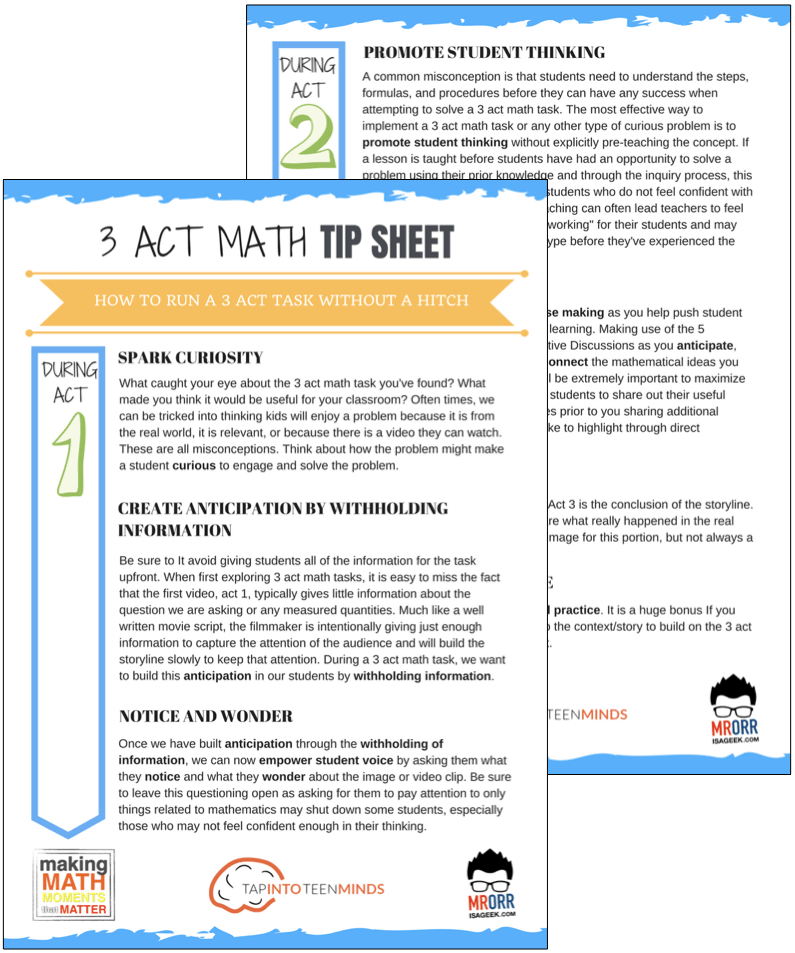
LESSONS TO MAKE MATH MOMENTS
Each lesson consists of:
Each Make Math Moments Problem Based Lesson consists of a Teacher Guide to lead you step-by-step through the planning process to ensure your lesson runs without a hitch!
Each Teacher Guide consists of:
- Intentionality of the lesson;
- A step-by-step walk through of each phase of the lesson;
- Visuals, animations, and videos unpacking big ideas, strategies, and models we intend to emerge during the lesson;
- Sample student approaches to assist in anticipating what your students might do;
- Resources and downloads including Keynote, Powerpoint, Media Files, and Teacher Guide printable PDF; and,
- Much more!
Each Make Math Moments Problem Based Lesson begins with a story, visual, video, or other method to Spark Curiosity through context.
Students will often Notice and Wonder before making an estimate to draw them in and invest in the problem.
After student voice has been heard and acknowledged, we will set students off on a Productive Struggle via a prompt related to the Spark context.
These prompts are given each lesson with the following conditions:
- No calculators are to be used; and,
- Students are to focus on how they can convince their math community that their solution is valid.
Students are left to engage in a productive struggle as the facilitator circulates to observe and engage in conversation as a means of assessing formatively.
The facilitator is instructed through the Teacher Guide on what specific strategies and models could be used to make connections and consolidate the learning from the lesson.
Often times, animations and walk through videos are provided in the Teacher Guide to assist with planning and delivering the consolidation.
A review image, video, or animation is provided as a conclusion to the task from the lesson.
While this might feel like a natural ending to the context students have been exploring, it is just the beginning as we look to leverage this context via extensions and additional lessons to dig deeper.
At the end of each lesson, consolidation prompts and/or extensions are crafted for students to purposefully practice and demonstrate their current understanding.
Facilitators are encouraged to collect these consolidation prompts as a means to engage in the assessment process and inform next moves for instruction.
In multi-day units of study, Math Talks are crafted to help build on the thinking from the previous day and build towards the next step in the developmental progression of the concept(s) we are exploring.
Each Math Talk is constructed as a string of related problems that build with intentionality to emerge specific big ideas, strategies, and mathematical models.
Make Math Moments Problem Based Lessons and Day 1 Teacher Guides are openly available for you to leverage and use with your students without becoming a Make Math Moments Academy Member.
Use our OPEN ACCESS multi-day problem based units!
Make Math Moments Problem Based Lessons and Day 1 Teacher Guides are openly available for you to leverage and use with your students without becoming a Make Math Moments Academy Member.
Partitive Division Resulting in a Fraction
Equivalence and Algebraic Substitution
Represent Categorical Data & Explore Mean
Downloadable resources including blackline masters, handouts, printable Tips Sheets, slide shows, and media files do require a Make Math Moments Academy Membership.
ONLINE WORKSHOP REGISTRATION
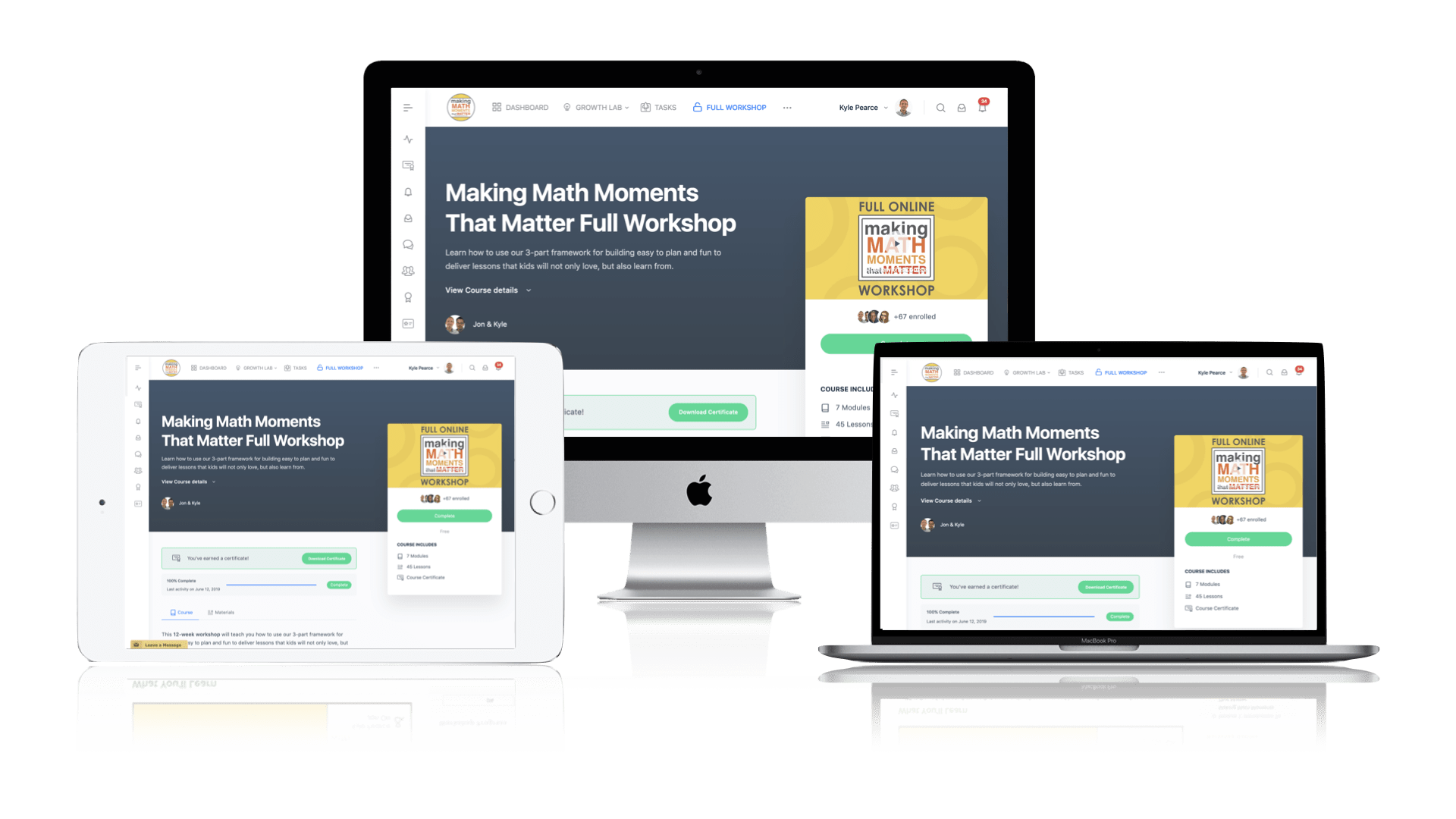
Pedagogically aligned for teachers of K through Grade 12 with content specific examples from Grades 3 through Grade 10.
In our self-paced, 12-week Online Workshop, you'll learn how to craft new and transform your current lessons to Spark Curiosity, Fuel Sense Making, and Ignite Your Teacher Moves to promote resilient problem solvers.
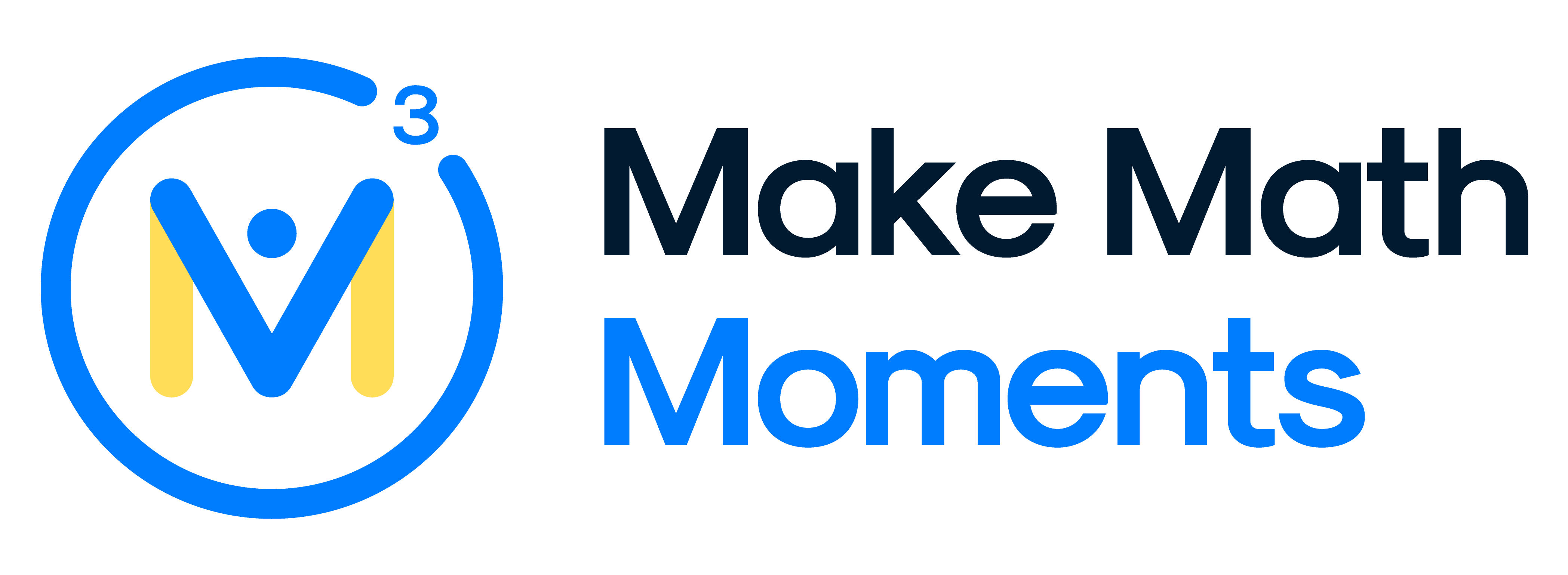



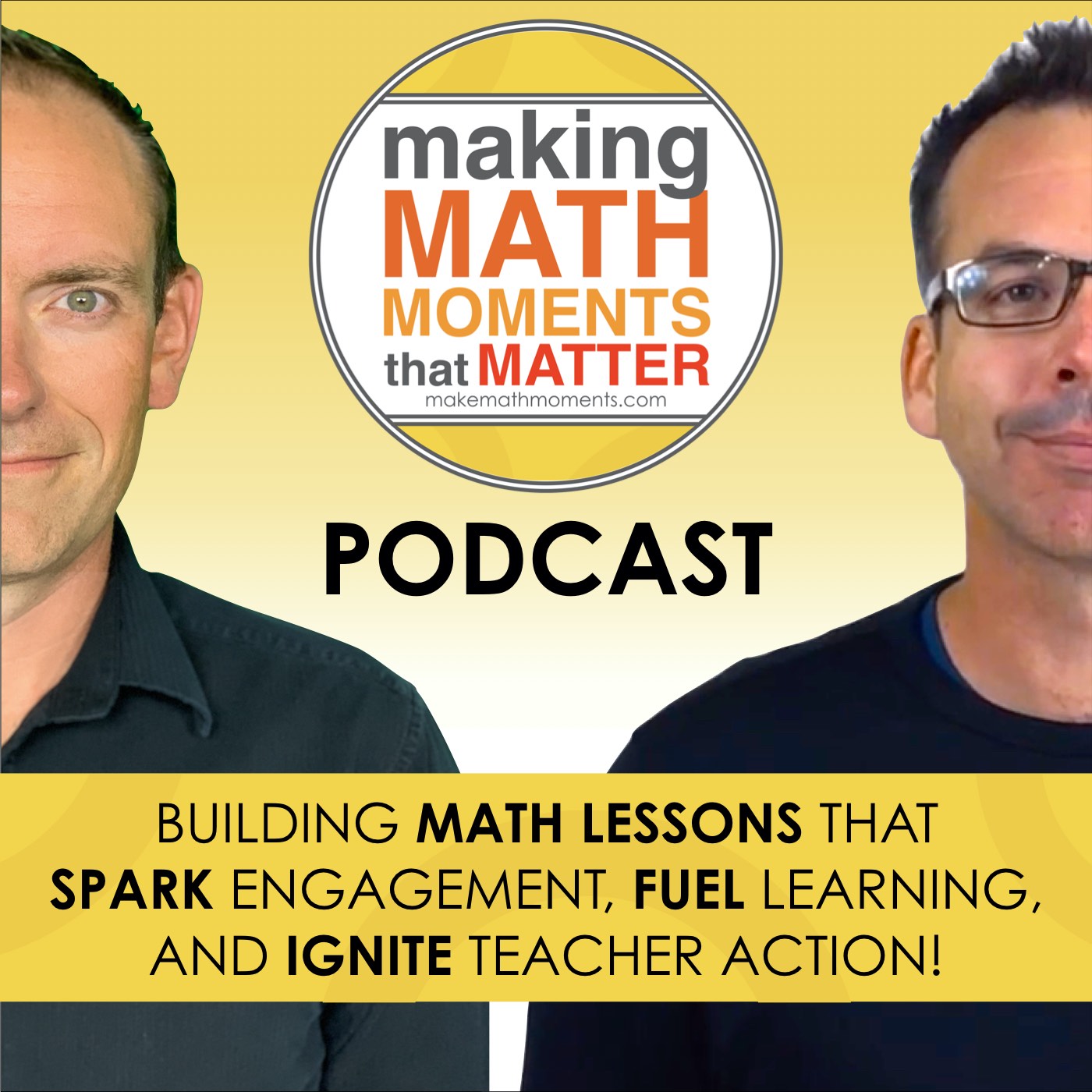
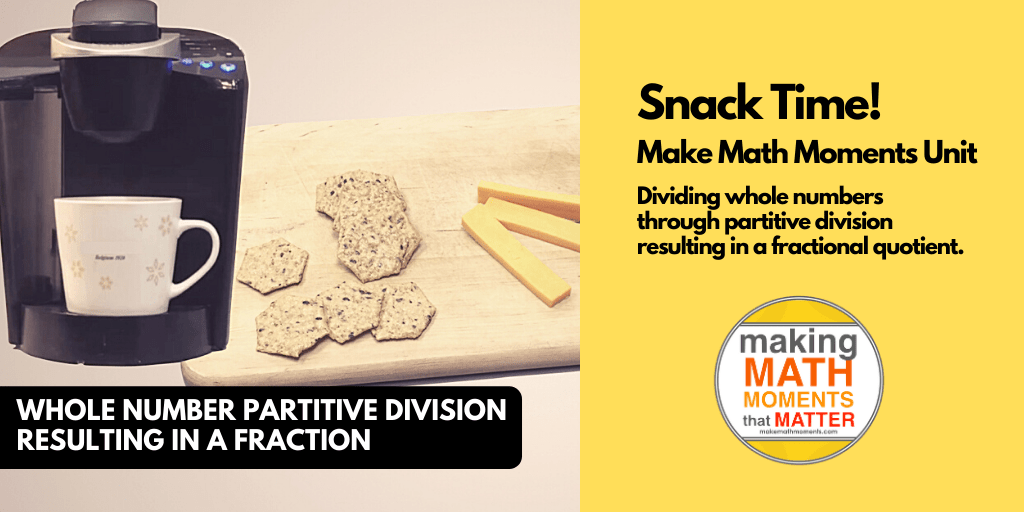
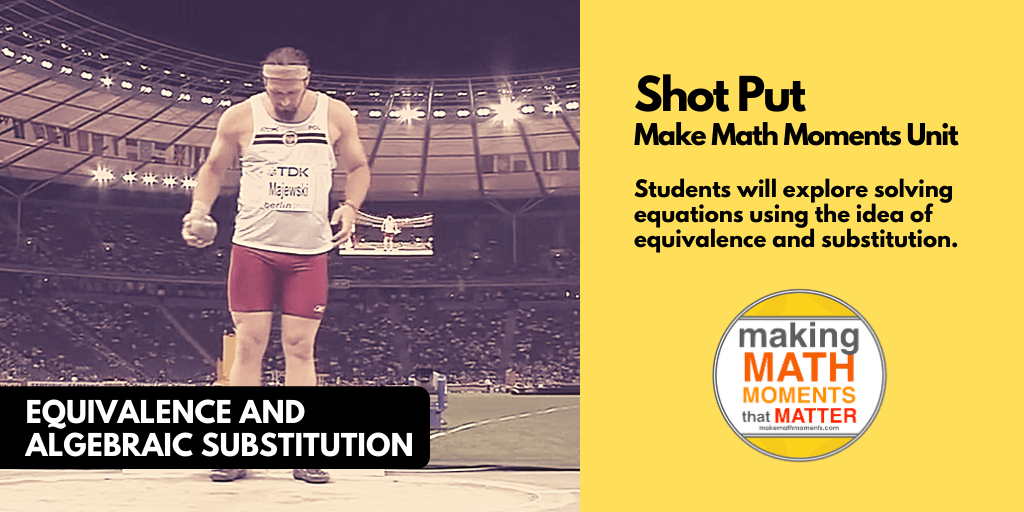
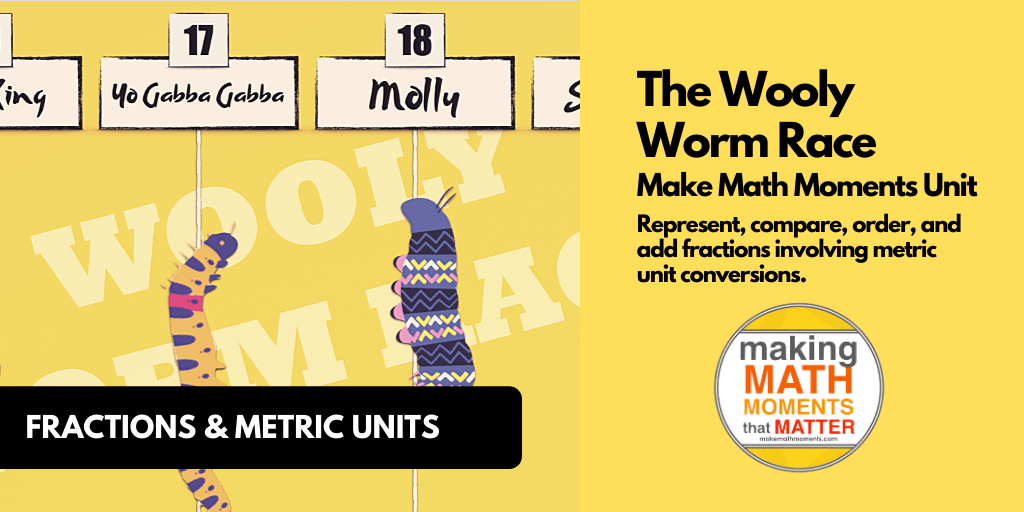
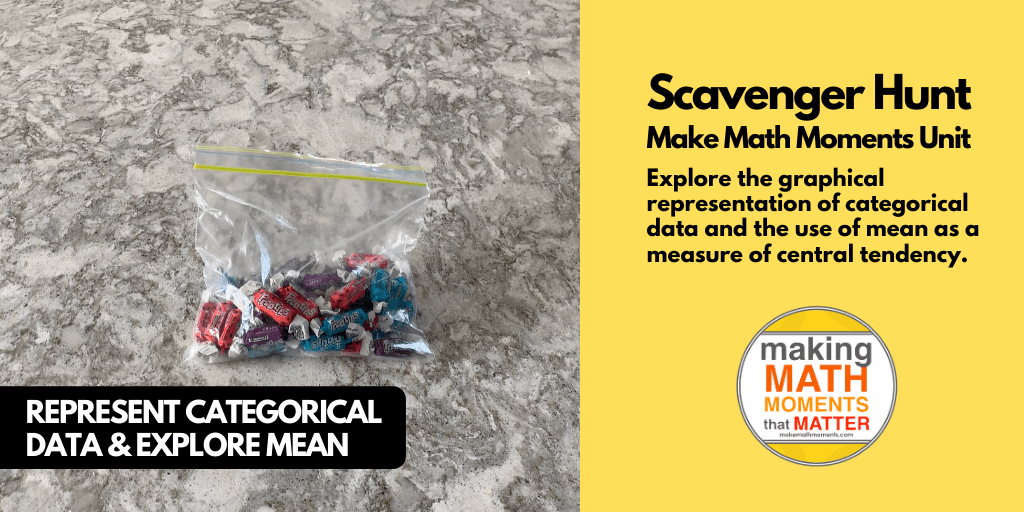

0 Comments